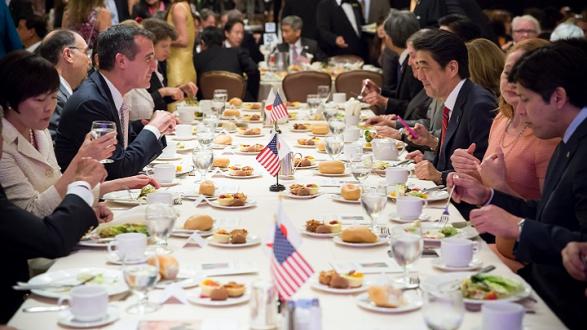With the conclusion of Japan Prime Minister Shinzo Abe’s recent visit to Washington, the docket is full of important issues relevant to America's most crucial bilateral relationship in the Pacific Rim. The U.S.-Japan relationship – stronger than ever – is the foundation for peace and stability in East Asia.
While the bulk of Abe’s hefty policy agenda was addressed in high-level meetings in Washington, the symbolic significance of his visit to California — where the proverbial rubber really hits the road in Japan’s relationship with America — may have been the most significant portion of the visit for three key reasons.
Trade
Former Rep. David Dreier, R-CA., recently declared that given the region’s significant trade and engagement with Asia, "California is the Silk Road of the third millennium.” The ports of Los Angeles account for more than 40 percent of America’s total international trade and more than one quarter of America’s trade with Japan, valued at more than $43 billion per year alone.
Cooperation with Asia, particularly Japan, has long been vital to the economic success of California. Los Angeles Mayor Eric Garcetti recently said, “Looking to Asia is natural for us [in California]. Those on the East Coast talk about a pivot, but we've never stopped looking at Asia."
At the top of the California economy’s wish list is the ratification and implementation of the Trans-Pacific Partnership (TPP), a massive trade agreement between the U.S., Japan, and other countries that total up to 40 percent of the world’s GDP.
As President Barack Obama and Prime Minister Abe work to reach a deal that would pave the way for the larger TPP pact, no state stands to benefit more than California. With an increasing number of California jobs dependent on international trade, the TPP’s impact on California’s economy and workers will be both significant and positive.
Cooperation with Asia, particularly Japan, has long been vital to the economic success of California.
The TPP will, as Obama has repeatedly argued, open new markets overseas, improve opportunity for small businesses, and enhance the robustness of California’s trade sector.
Investment
California continues to be the No. 1 destination in the United States for Japanese direct investment. Japan is the No. 1 source of overall foreign investment into California, contributing about $24 billion per year. There are more than 1,700 Japanese companies throughout California, more than any other state in the country.
Japanese investment in Southern California is particularly significant; $8.8 billion total estimated annual Southern California payroll can be attributed to Japanese companies, and nearly a third of foreign-owned business in Los Angeles is Japanese.
Despite Toyota’s recent announcement to move its North American headquarters from Torrance to Texas, and the increasing presence of Korean, Chinese, and European investors, Japanese investment still remains the most significant source of foreign capital in California.
$8.8 billion total estimated annual Southern California payroll can be attributed to Japanese companies, and nearly a third of foreign-owned business in Los Angeles is Japanese.
During Abe’s visit to Silicon Valley, he promoted Japan as a continued partner for the technology sector. He is aiming to make innovation and technological advancement core parts of his grand reform of Japan's economy.
The Japanese consumer market is shifting toward adopting new American technological products, including social media; Google’s Asia headquarters is in Tokyo, and the booming tech sector is keen to penetrate the Japanese market in a more meaningful way.
Community ties
Japan and California have a deep and historic connection. California boasts the largest number of Japanese nationals living in the United States, as well as the most Americans of Japanese ancestry.
For Prime Minister Abe, this visit to Los Angeles is particularly significant because he studied at the University of Southern California. Although the overall number of Japanese students in the United States has declined, UCLA and USC rank first and second, respectively, for number of Japanese students at U.S. universities.
All three of America’s so-called Japantowns — Los Angeles (Little Tokyo), San Francisco and San Jose — are in California, as well as West Los Angeles’ Little Osaka neighborhood and Torrance.
The ties are clear even at a basic level: California has the most Japanese restaurants of any state! From the Japanese American National Museum to Nisei Week (which is celebrating its 75th anniversary), and from California’s 42 Japanese prefectural associations to the dozens of Japanese daily, weekly and monthly publications, the depth and breadth of California’s relationship with Japan is an essential part of California’s identity and economy.
For Prime Minister Abe, this visit to Los Angeles is particularly significant because he studied at the University of Southern California.
As Abe addressed large, diverse crowds in Los Angeles, the unique and historic relationship that exists between the people from both sides of the Pacific was evident.
Because the rich bonds that tie the people and economies of Japan and California are key to making the trans-Pacific relationship stronger, the prime minister’s time in the Golden State will prove to be the highlight of his official visit to the United States.
____________________
Jonathan Beutler is the founder of Pacific Rim Advisory, a California-based international public affairs firm, a former U.S. diplomat, and a member of the Pacific Council on International Policy. He is also a fellow with the Truman National Security Project.
The views and opinions expressed here are those of the author and do not necessarily reflect the official policy or position of the Pacific Council.




